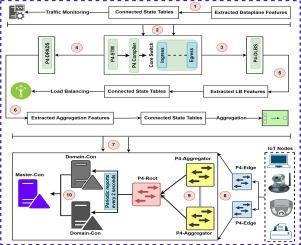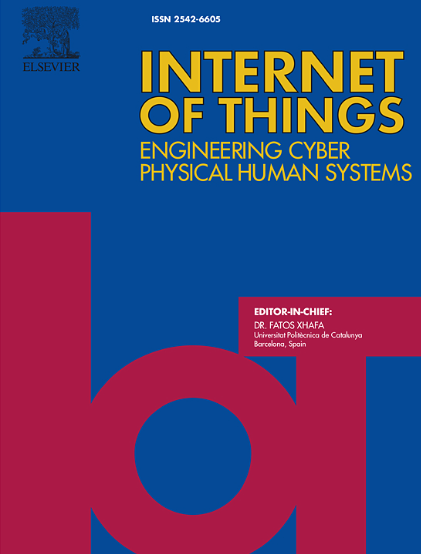LBTMA: An integrated P4-enabled framework for optimized traffic management in SD-IoT networks
IF 7.6
3区 计算机科学
Q1 COMPUTER SCIENCE, INFORMATION SYSTEMS
引用次数: 0
Abstract
This research introduces LBTMA, a novel framework for effective traffic management in Internet of Things (IoT) networks employing software-defined networking (SDN). LBTMA comprises three modules: P4-enabled Stateful Traffic Monitoring (P4-STM), P4-enabled Distributed Load Balancing (P4-DLBS), and P4-enabled Distributed Packet Aggregation and Disaggregation (P4-DPADS). Operating entirely within the data plane, the three modules collaboratively address the challenges of managing high communication traffic from IoT devices. P4-STM utilizes state tables for flow monitoring and anonymization, while introducing a novel multi-controller communication scheme (MCCS) that separates routine data from critical alerts through two dedicated channels. MCCS demonstrated a 25% improvement in throughput and a 51% decrease in latency compared to single controller architecture. P4-DLBS features Enhanced Weighted Round Robin (P4-EWRR) load balancing algorithm, which leverages P4′s distributed decision-making capabilities and inter-switch coordination for enhanced scalability and reduced controller burden. P4-EWRR continuously adjusts server weights based on real-time factors (e.g., queue length, server resource pool, CPU utilization) to ensure efficient resource allocation. In testing, P4-EWRR achieved an average response time of 15 ms and an average packet drop rate of 2%. P4-DPADS employs a hierarchical data plane to efficiently handle high volumes of small IoT packets. It demonstrated an average disaggregation accuracy of 98%, communication overhead reduction rate of 70%, and an impressive average aggregation ratio of 95%. Additionally, P4-DPADS contributes to a 25% reduction in latency and a 40% increase in throughput. The LBTMA framework's modularity and P4 programmability provide flexible, scalable, and efficient traffic management in IoT networks.

LBTMA:用于优化 SD-IoT 网络流量管理的 P4 功能集成框架
本研究介绍了 LBTMA,这是一种在采用软件定义网络(SDN)的物联网(IoT)网络中进行有效流量管理的新型框架。LBTMA 由三个模块组成:支持 P4 的状态流量监控(P4-STM)、支持 P4 的分布式负载平衡(P4-DLBS)和支持 P4 的分布式数据包聚合和分解(P4-DPADS)。这三个模块完全在数据平面内运行,共同应对管理来自物联网设备的高通信流量的挑战。P4-STM 利用状态表进行流量监控和匿名化,同时引入了新颖的多控制器通信方案(MCCS),通过两个专用通道将常规数据与关键警报分开。与单控制器架构相比,MCCS 的吞吐量提高了 25%,延迟降低了 51%。P4-DLBS 采用增强型加权轮循(P4-EWRR)负载平衡算法,该算法利用 P4 的分布式决策能力和交换机间协调能力,增强了可扩展性并减轻了控制器的负担。P4-EWRR 根据实时因素(如队列长度、服务器资源池、CPU 利用率)不断调整服务器权重,以确保高效的资源分配。在测试中,P4-EWRR 的平均响应时间为 15 毫秒,平均丢包率为 2%。P4-DPADS 采用分层数据平面,可有效处理大量小型物联网数据包。它的平均分解准确率达到 98%,通信开销减少率达到 70%,平均聚合率达到 95%,令人印象深刻。此外,P4-DPADS 还将延迟降低了 25%,吞吐量提高了 40%。LBTMA 框架的模块化和 P4 可编程性为物联网网络提供了灵活、可扩展和高效的流量管理。
本文章由计算机程序翻译,如有差异,请以英文原文为准。
求助全文
约1分钟内获得全文
求助全文
来源期刊

Internet of Things
Multiple-
CiteScore
3.60
自引率
5.10%
发文量
115
审稿时长
37 days
期刊介绍:
Internet of Things; Engineering Cyber Physical Human Systems is a comprehensive journal encouraging cross collaboration between researchers, engineers and practitioners in the field of IoT & Cyber Physical Human Systems. The journal offers a unique platform to exchange scientific information on the entire breadth of technology, science, and societal applications of the IoT.
The journal will place a high priority on timely publication, and provide a home for high quality.
Furthermore, IOT is interested in publishing topical Special Issues on any aspect of IOT.
 求助内容:
求助内容: 应助结果提醒方式:
应助结果提醒方式:


